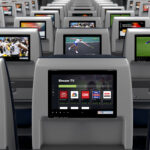
Investing in Live Sports for In-Flight Entertainment Helps Airlines’ Bottom Lines
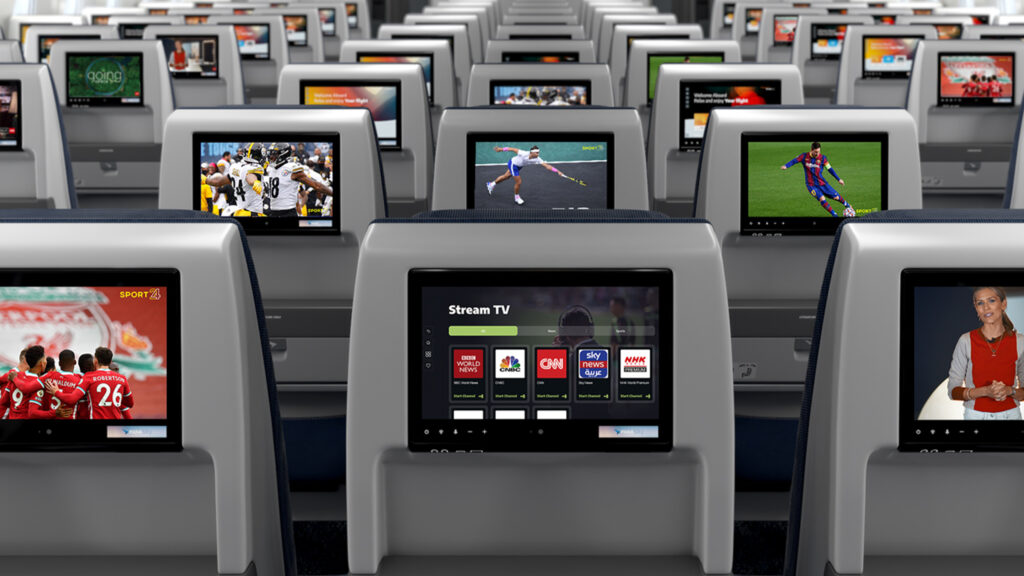
It is increasingly common for an airline to offer some kind of in-flight entertainment for its passengers, whether through seatback screens or personal devices. One way that airlines can further improve their bottom lines is by adding live sports to their in-flight entertainment (IFE) offering.
Customers have always cared about the quality of the in-flight experience. As air travel makes a comeback from the challenges of the COVID-19 pandemic, it’s even more important to consider what components contribute to a positive experience for passengers.
Watching live events is a unique and valuable experience for many across the world. Especially for national and international competitions, like the World Cup, in-flight viewership can increase tenfold, according to Dominic Green, Senior Director of Product Line Management at Panasonic Avionics. “To harness that ability [to watch live events]—and to take credit for it as an airline that provides access to these unmissable moments—is extremely powerful for curators of the passenger experience,” he explained.
Green added, “Showing live sports on board brings the in-air experience closer to the expectations consumers have on the ground.”
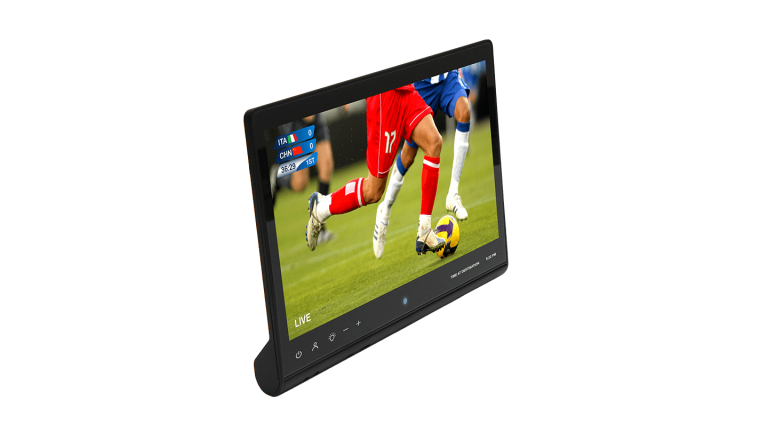
Airlines can take advantage of the widespread interest in sports by making live events available for viewing in-flight. Men account for about 60% of the market for sports viewership, but women are responsible for purchasing close to half of all NFL merchandise. In fact, nearly 80% of all sales of sports apparel are conducted with women, according to a recent NYU study cited by Panasonic.
Panasonic Avionics has partnered with IMG to offer Sport 24 and Sport 24 Extra for in-flight entertainment. Live sports are a core part of Panasonic’s offerings for passenger engagement, in addition to live news. According to the company, including live sports with IFE can have a positive impact on budgetary efficiency and tangible metrics.
“Live content is unmissable, and the must-see element can mean changing the way airlines think about appropriating content budgets,” Green shared.
He added, “More time spent engaging with other content experiences like maps or live television means less time and resources that airlines need to allocate in pursuing giant, expensive libraries of content.”
Panasonic Avionics provides high-speed in-flight connectivity for the commercial aviation industry. Their connectivity services provide coverage for 99.8% of global flight routes. Panasonic and OneWeb entered into a distribution agreement to add low earth orbit (LEO) networks to Panasonic’s satellite network. The company’s single panel antenna, or SPA, is a Ku-band antenna with a simplified design that is mounted on the fuselage. Panasonic invests in electronically-steered antennas (ESAs) for LEO and GEO constellations.
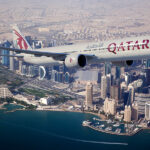
Qatar Airways Expands IFC Agreement With Inmarsat for Boeing 787-9 and 737-10 Fleet
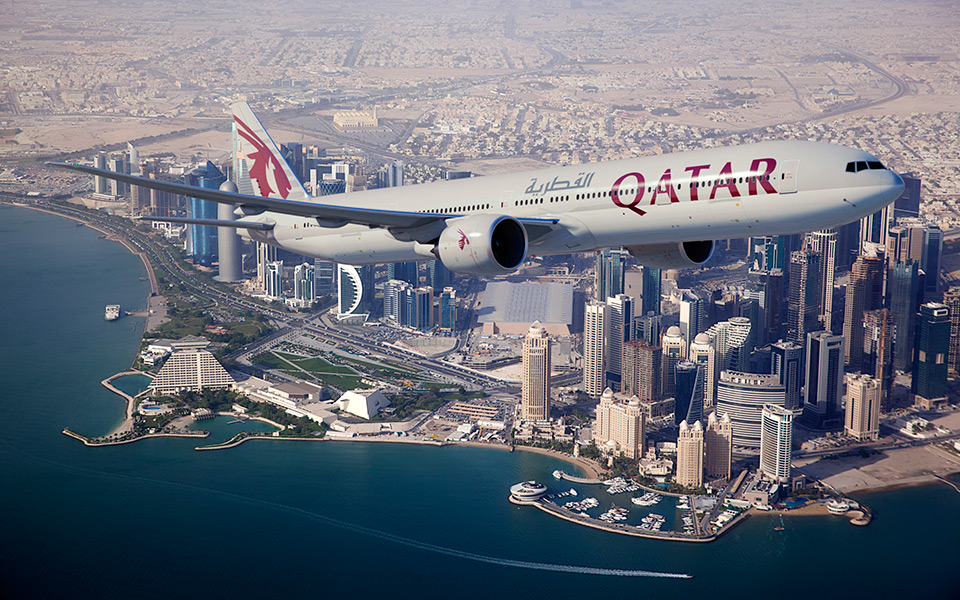
Qatar Airways selected Inmarsat’s in-flight connectivity (IFC) solution for its Boeing 787-9 and 737-10 fleet. This is an expansion of an agreement the companies signed in 2017 to install GX Aviation on the airline’s Airbus A350s and Boeing 777s.
GX Aviation has been activated on the first seven Boeing 787-9s, less than five months from contract award, the companies announced Wednesday.
Qatar Airways said this IFC expansion is particularly important as Qatar prepares to host the 2022 FIFA World Cup in November, bringing an influx of tourists to the country. Inmarsat is committed to meeting the bandwidth requirements for this event, and Qatar Airways plans to offer passengers match scores, video replays and game livestreams. The airline’s service model is to offer one hour of free access to its Super Wi-Fi with the option to purchase full access for the remainder of each flight.
“We were amongst the first airlines in the world to adopt [Inmarsat GX Aviation] and remain the largest operator of GX-equipped aircraft in the Middle East and North Africa,” said Akbar Al Baker, Qatar Airways Group Chief Executive. “As the 2022 FIFA World Cup approaches, Inmarsat is the perfect partner we need to ensure Qatar Airways can offer unrivaled inflight connectivity to each and every passenger.”

In-Flight Connectivity Players Revisit Questions About the Business Model Versus Demand

PARIS — Mobility, and in particular aviation, remains a key barometer for the satellite industry, as it looks to diversify its revenue streams away from video/broadcast. In-flight Connectivity (IFC) remains a key target market for many big players. The market was shaken up this year when Starlink announced a deal with Hawaiian Airlines.
Against this backdrop, at World Satellite Business Week (WSBW), executives from El Al Airlines in Israel, Corsair, Anuvu, and Gogo Business Aviation examine the current state of IFC and what is next for a market that has had a turbulent couple of years.
Tal Kalderon, head of In-Flight Entertainment & Connectivity, El Al gave an interesting perspective from an airline point of view. He said that El Al has seen a significant upswing in terms of people looking to fly and that the demand for connectivity is high as well. Customers continue to expect the same level of connectivity service they get on the ground.
However, given the investment involved, going to a completely free model for an airline could be difficult to justify. He said, “I hope in the future it will be free, but I don’t know yet, but that is the plan. In short haul flights, people don’t use things like Netflix and Spotify. We give connectivity free to business class passengers. The demand for connectivity in flights to Europe is quite low. However, having said that, passengers would still like to have the option, so we still offer it as a possibility on short haul flights.”
The ultimate vision for El Al is to not have separate IFC and IFEC [in-flight entertainment and connectivity] systems, and have one IFC system that powers everything. Kalderon added, “The dream of El Al is to have only one system. Today, we have IFC and IFEC. In the future, passengers will get all the content and services through an IFC system. Ultimately, we won’t need to provide movies on a server. Most airlines are going for free, even if just for business class. Most providers are working on ways to get streamed content to the aircraft.”
Kalderon admits it is important that an airline has access to the best technology when it comes to IFC, even if replacing equipment means it is tricky to make decisions. “We must always make sure we are getting the best technology. So, previously it was Ka-band. Technology is progressing fast. We know it is a huge investment. We don’t see a choice. The demand is growing all the time,” he said. “We don’t know yet what future iterations of technology will look like. I don’t believe in the next few years, we will change the antennas or the hardware on board, as an example. But, if we find out, the technology isn’t providing what we want, we have SLAs with our providers. We need to ensure we have the best technologies.”
Enea Fracassi, COO of Corsair, a French charter airline, said they had a good summer, but one noticeable change was people are taking a much shorter term outlook when booking flights.
When talking about the importance of connectivity, he said, “People are really careful about the price [when booking flights]. Price is still the priority. I don’t think connectivity is a driver when people are booking flights. The take-up rate [of IFC] is still quite low. Having said that, a Wi-Fi connection is becoming an essential. It is becoming part of the landscape. Most people want it as part of the package.”
Like El Al, making it successful from a business point of view remains a challenge. Fracassi said, “I haven’t met any airline that has made a success of it (IFC) in terms of P&L. We need to keep systems very simple. We are dealing with a number of providers and this isn’t easy.”
Anuvu has plans to launch its own constellation of satellites to offer a more well-rounded service to airlines. Josh Marks, CEO, Anuvu said the industry was at a “transformational point.” He spoke about the ‘free’ model and how ultimately it could be seen to pay off for airlines. He said: “A number of clients have gone ‘free’ on Wi-Fi, and that drives 30 percent take-up rates. If you have a platform, and you can get that number up to 80 percent of the flight accessing connectivity, there is a chance to market it, and offer personalized services to customers. What we are hearing from airlines is how can we make this profitable as an investment?”
In terms of its own approach, Marks says Anuvu believes in an ecosystem business model, and that this will provide the best value for airlines.
“Our view of the world is a hybrid approach is the right one. So, one where you can have multiple technologies. What we are looking at now is an ecosystem model. We are launching our own constellation. The rapid development of LEO is key to this ecosystem,” he said. “GEO satellites have a key role also. They definitely help in terms of capacity scalability. From a customers’ perspective, the system has to work 100 percent of the time. We have to re-orientate how we think about satellite coverage around the world. The constellation is there to provide additional coverage.”

JSX CEO Gives Starlink In-Flight Internet Updates at FTE Global
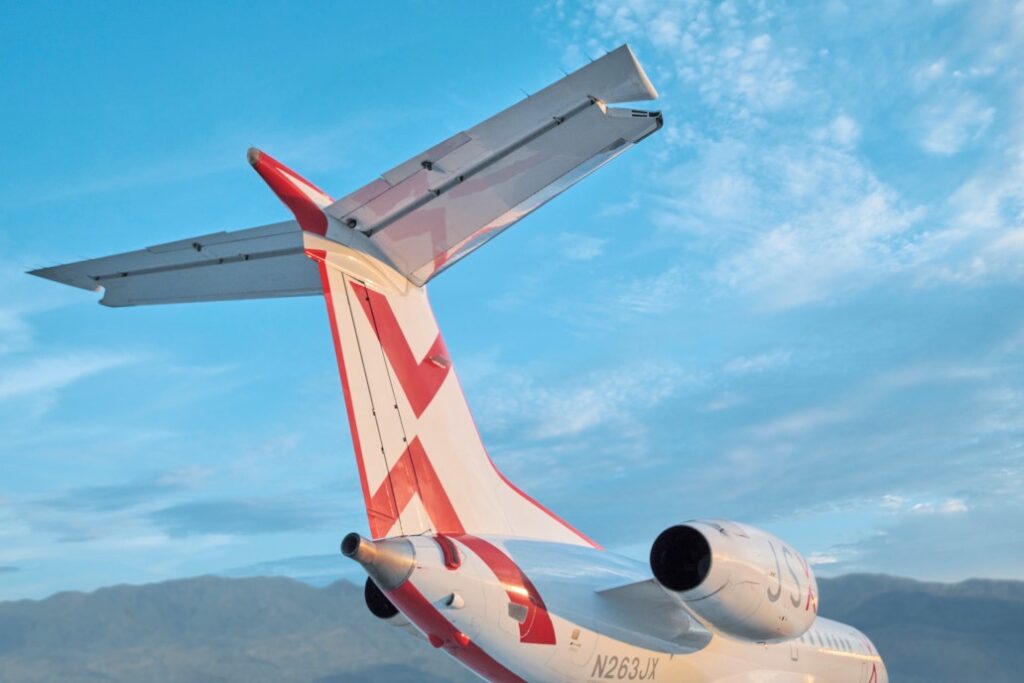
JSX expects to begin operating its first passenger-carrying flight featuring SpaceX’s Starlink in-flight connectivity (IFC) service by October, according to comments made by the charter operator’s CEO Alex Wilcox at the Future Travel Experience (FTE) Global event earlier this month.
The California-based company was confirmed as the launch air carrier for Starlink IFC in April, marking SpaceX’s first entry into the commercial aviation IFC market. During his participation in the FTE panel discussion “In-flight Experience 2030,” Wilcox provided a timeline for the launch for the new service and some insight into how it will work.
“Probably the number one complaint we get from customers is no Wi-Fi. We’re the launch customer for SpaceX Starlink Wi-Fi solution, that will be on every airplane by the end of this year,” Wilcox said, adding that the first Starlink-equipped JSX flight should occur by October.
Starlink is a constellation of Low-Earth Orbit (LEO) satellites with a focus on enabling broadband internet service in remote areas. SpaceX has launched more than 3,000 Starlink satellites for the constellation this year, according to recent reporting by Via Satellite, a sister publication to Avionics International.
JSX operates a fleet of 77 total Embraer 135s and 145s, and currently has Starlink antennas, modems, and wireless access points installed and testing on two of its aircraft. Wilcox described the performance of Starlink on those two aircraft as working “amazingly well.”
The JSX co-founder said that even with the technology still in testing mode, they were actually able to use it as an alternative to airport internet service. According to Wilcox, during a recent internet service outage at Hollywood Burbank Airport, JSX airline staff took a laptop onboard one of their Starlink-equipped aircraft and used that to check passengers in instead.
“That’s how good it is,” Wilcox said.
While JSX already confirmed that it will offer the service free of charge to passengers, Wilcox provided more insight into how the Starlink IFC service will be operated and accessed.
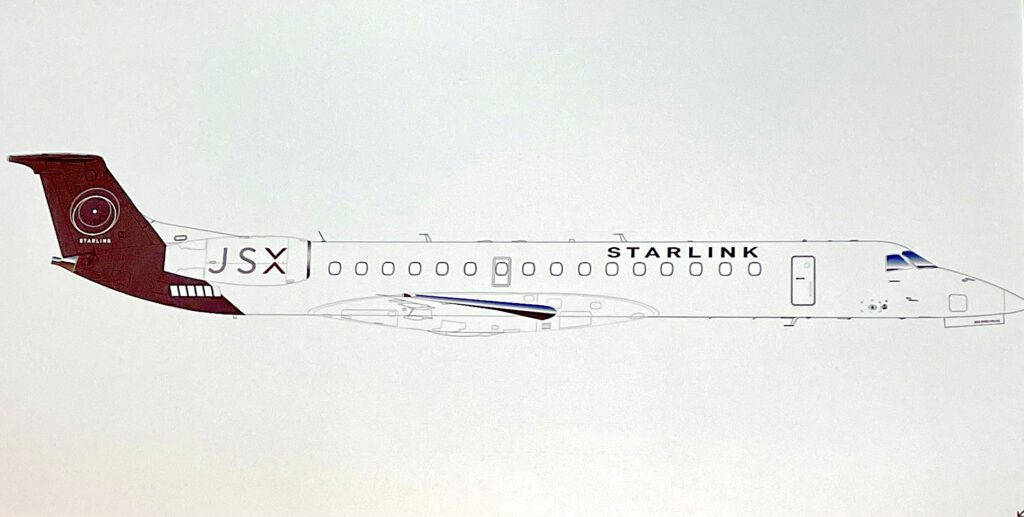
“That’s going to be lounge to lounge service, the second you get on the airplane, all you need to do is click on the SSID and you’re on,” he said. “There’s no login, no credit card, nothing, just on and open for everybody. It’s 200 mbps to the airplane and it’s awesome.”
When asked whether JSX would consider adding seatback in-flight entertainment (IFE) screens to its Embraer fleet, the air carrier’s CEO said he believes they’re “firmly in the bring your own screen camp” and does not see that investment happening any time soon.
Hawaiian Airlines was confirmed as SpaceX’s first major commercial airline customer shortly after JSX became the launch air transportation customer in April. Hawaiian will also offer the service to passengers for free, and expects to begin equipping its aircraft with Starlink terminals next year.
SpaceX’s top Starlink executive, Jonathan Hofeller, said during his appearance at the Connected Aviation Intelligence Summit earlier this year that several other airline agreements are in the works as well.

Spirit Airlines CIO Eyes Use of In-Flight Connectivity to Transmit Flight Operational Data

LAS VEGAS — Two months after switching its new in-flight internet service on for the first time, Spirit Airlines Chief Information Officer (CIO) Rocky Wiggins provided more insight into how the low-cost airline wants to expand its use of connectivity for both passengers and operations.
Spirit first started providing in-flight connectivity (IFC) to passengers on some of its Airbus A320 fleet in July, and will continue equipping its entire fleet with the service over the next few years. During a fireside chat session at the Future Travel Experience (FTE) Global event in Las Vegas this week, Wiggins explained how Spirit wants to optimize its use of connectivity for both passengers and flight operations in the near future.
“The things you can look forward to in the near future will [include extending] the product from a 10,000-foot limit to gate-to-gate,” Wiggins said.
According to Thales, Spirit’s IFC service is enabled by a set of strategic agreements first established with satellite operators SES and Hughes Network Systems in 2017. Under the agreements, SES contracts Hughes for service on EchoStar XVII and EchoStar XIX HTS satellites, and combines them with its AMC-15 and AMC-16 satellites to provide the four-satellite network initially enabling connectivity for Spirit passengers.
In August, Thales confirmed through a post on its LinkedIn account that some of Spirit’s aircraft have also started connecting to a fifth high throughput satellite (HTS), SES-17. In-flight internet purchasing options for Spirit passengers have been separated into a browsing category that starts at $2.99 and a streaming category that starts at $5.99.
While acknowledging the benefits of providing passenger connectivity during his fireside chat at FTE, Wiggins also discussed how Spirit views its return on investment related to the new IFC service and whether charging passengers for access could provide ancillary revenue. Eventually, he believes the airline could exploit the service for transmitting operational data about aircraft components and system faults or maintenance needs in real time.
“The return on that investment is a bit squishy, it’s further out and it requires a tremendous amount of discovery,” Wiggins said, regarding the potential to create ancillary revenue from passengers paying for IFC.
But the Spirit CIO said there could be major potential in using the connectivity to transmit operational data in real time. In recent years, both airlines and in-flight connectivity service providers have offered a wide variety of perspectives on how high-speed connectivity can be used to stream flight operational data to ground crews or operations bases to inform them of potential aircraft maintenance issues or items that need to be addressed once an aircraft lands.
Viasat for example, features a data sheet on its website explaining how their partnership with Teledyne enables the use of a connected aircraft interface device (AID) to transmit real-time flight data for “enhanced flight and maintenance operations” that the company claims can be done at a lower charge than sending that data over the aircraft communications, addressing and reporting system (ACARS). In April, the Collins Aerospace-sponsored publication Connected Aviation Today featured an interview with a UPS flight operations manager discussing the concept of predictive maintenance.
Airbus also discussed the topic in April for an article published by FAST, their internally distributed online magazine. “The crew can also use the SATCOM to contact the [Airline Operations Center] AOC regarding, for example, an HF system fault message alert during the flight which could impact the next flight dispatch,” the French airplane maker notes in the article.
Wiggins said Spirit is a big believer in the concept but has not yet started using its connectivity to transmit real-time operational data.
“We knew that we wouldn’t be getting engineering data off the aircraft in-flight right away, but as we put the Thales deal in place it already was structured to let us do that,” Wiggins said. “I can already point to a handful of events that I want to know right away that occur on the aircraft that I can transmit down to the destination airports so they can be ready to respond, that reduces our turn time. We have a handful of those, we think right now the potential is tremendous, and it’s going to require a significant amount of data mining, machine learning and discovery. We’re preparing to do that because we think the payoff could be quite huge in terms of aircraft utilization, turn time, and a less disruptive experience for our customers. But the program isn’t built on that.”

Will New DOT Rule Require US Airline Refunds When In-flight Internet Does Not Work?
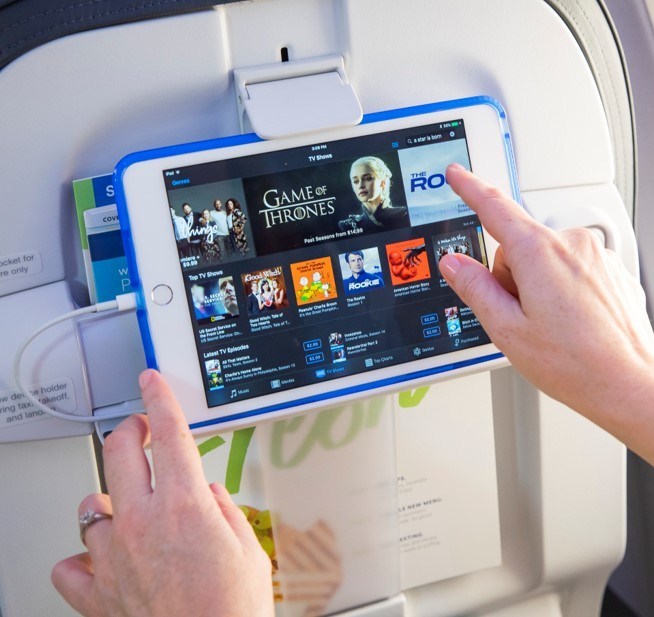
On September 26, the U.S. Department of Transportation released a new Notice of Proposed Rulemaking (NRPM) “Enhancing Transparency of Airline Ancillary Service Fees,” that could require U.S.-based airlines to provide refunds to passengers who pay for in-flight internet services that malfunction or do not work during their flight.
The NPRM was released as part of a White House Competition Council meeting held this week where U.S. government officials announced DOT’s NPRM as part of 72 other initiatives developed by more than a dozen federal agencies with the goal of addressing “some of the most pressing competition problems across our economy.” A major focus of DOT’s NPRM is to increase the level of transparency airlines are required to provide when passengers are purchasing air travel tickets to include disclosure of all fees such as checked baggage and preferred seating at the initial point of purchase.
“Airline passengers deserve to know the full, true cost of their flights before they buy a ticket,” U.S. Transportation Secretary Pete Buttigieg said in a Sept. 26 press release. “This new proposed rule would require airlines to be transparent with customers about the fees they charge, which will help travelers make informed decisions and save money.”
A provision within the NPRM would require airlines to provide refunds to passengers that pay for services that are not available or provided in-flight. DOT specifically references “broken WiFi” as one of those services that would require a refund in the new NPRM.
The agency also defines in-flight internet services as one of the ancillary revenue fees that airlines could be required to refund if the new rule becomes effective. DOT proposed the rule on Sept. 26 and is allowing a 60-day comment period on its details. Check out the full 72-page NPRM here.

United Airlines Gives T-Mobile Users Free In-flight Connectivity
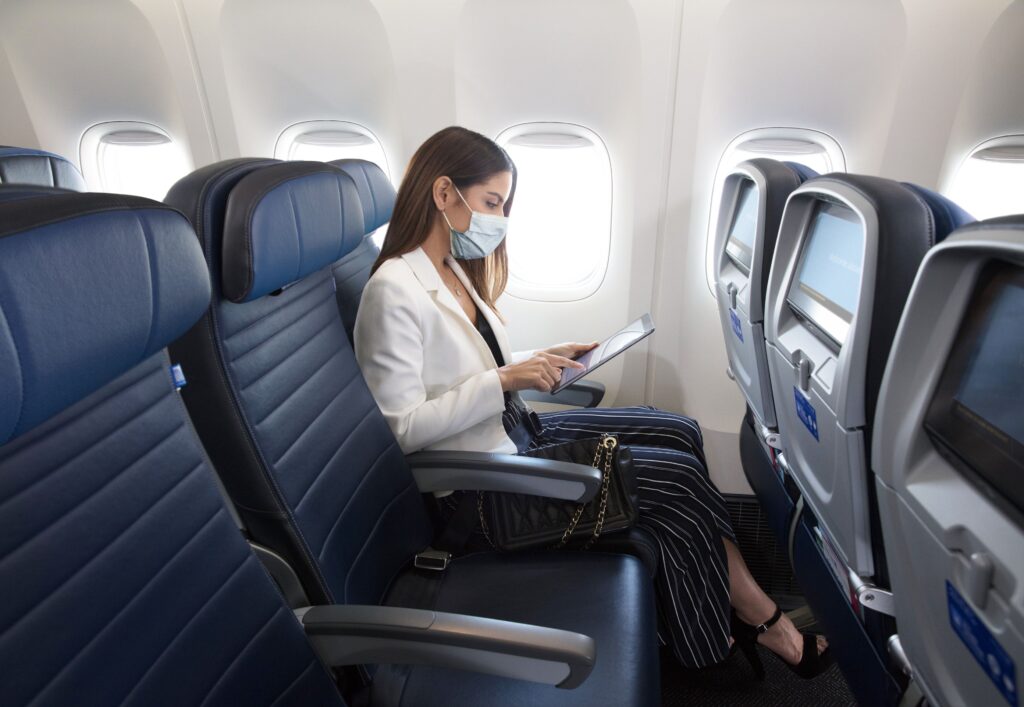
United Airlines has become the latest major U.S. air carrier to provide certain T-Mobile customers access to free in-flight connectivity (IFC) services where available.
T-Mobile announced similar “Un-carrier” deals with American, Alaska and Delta Air Lines in June. Under these new agreements between T-Mobile, the airlines and their respective in-flight connectivity service providers, T-Mobile users of certain cellular plans get the “ability to text, email, search and stream all flight long where available,” according to the company’s announcement this week.
“Whether it’s for business or leisure, we know staying connected in the air is important, and we’re excited many of T-Mobile’s customers will experience our free inflight Wi-Fi on their phones when flying United,” Grant Milstead, United’s Vice President of Digital Technology, said in a Sept. 23 press release. “With the free in-flight coverage, customers can take advantage of Wi-Fi to text their family and friends or browse their favorite sites and apps.”
Coverage Beyond is the new program T-Mobile rolled out in June, that includes partnerships and agreements the company has established with some of the leading in-flight connectivity service providers such as Viasat, Intelsat, Gogo and others.
To gain access to the free connection “all flight long,” the T-Mobile user must have “Magenta MAX, Business Unlimited Ultimate and equivalent Sprint plans,” according to their June 21 announcement.
“Now, T-Mobile customers can stay connected from takeoff to landing and beyond on hundreds more flights, now including United Airlines!” said Mike Sievert, CEO of T-Mobile, commenting on the latest airline to join the program.

Intelsat and OneWeb Partner on LEO/GEO In-Flight Connectivity

OneWeb and Intelsat have signed a global distribution agreement to offer a multi-orbit in-flight connectivity (IFC) service combining Low-Earth Orbit (LEO) and Geostationary Orbit (GEO) satellite capacity. The companies announced the agreement Thursday and expect it to be in service by 2024.
Under the agreement, Intelsat will distribute OneWeb capacity coupled with its service. Intelsat said this will fill gaps in IFC coverage and capacity at airport hubs, across oceans, and over polar routes.
“This level of connectivity will enable airlines to maximize brand affiliation with passengers through all their onboard services – delivering a truly connected end-to-end passenger journey,” said Jeff Sare, Intelsat’s new president Commercial Aviation. “The hybrid service offering further allows the global airline community to plan their suite of next-generation onboard services with confidence – not only ensuring a future-proofed passenger inflight connectivity experience, but also the implementation of a connected airline digitalization strategy.”
Ben Griffin, OneWeb vice president of Mobility Services, called the deal a “watershed moment” for the IFC market and said the partnership delivers the highest value for the lowest risk.
This partnership comes after Intelsat announced a new IFC solution in June, with a new multi-orbit capable, electronically steered array terminal to offer increased flexibility to its airline customers.
OneWeb is in the midst of a deal to combine with operator Eutelsat.

Private Jet Operator Airshare Selects Viasat In-flight Connectivity for New Aircraft
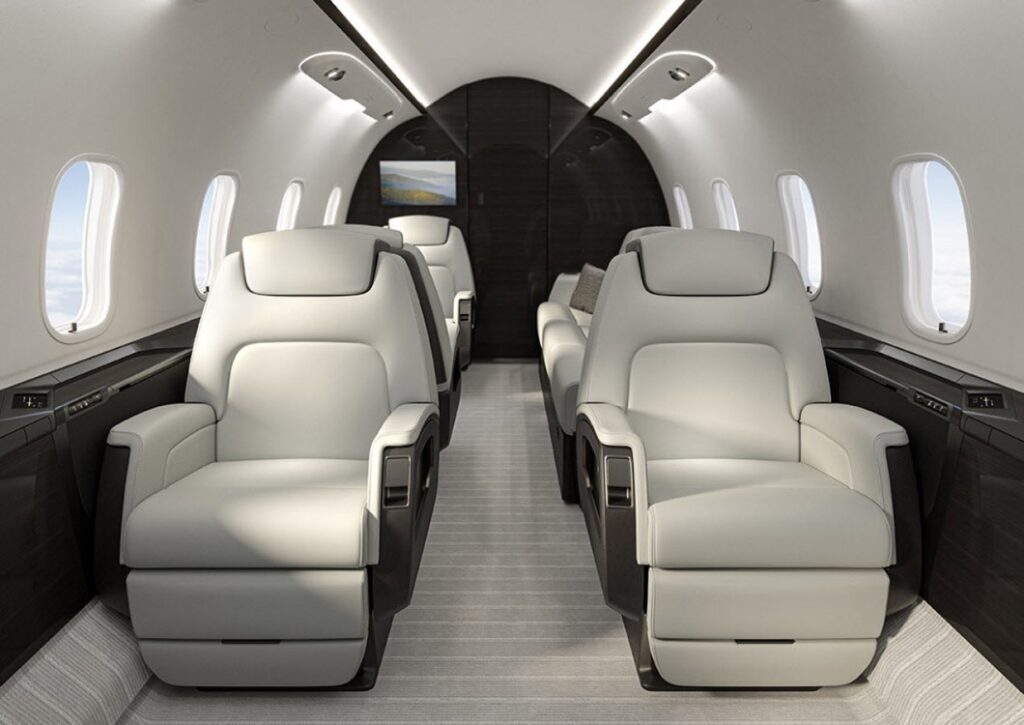
Private aviation company Airshare has selected Viasat’s in-flight connectivity (IFC) for new aircraft deliveries, Viasat announced Tuesday. Airshare’s business model offers “fractional ownership” of private jets, in which customers buy or lease access to private flights.
Viasat will install its IFC system on Airshare’s new Challenger 350 deliveries and future Challenger 3500 deliveries that begin next year. The Challenger planes are business aircraft built by Bombardier. The first installation on an Airshare Challenger 350 was completed in July and additional installations will take place over the second half of this year. Financial terms of the deal were not disclosed.
This deal comes as Airshare is expanding beyond its core markets in the central United States, with plans to begin service on the East Coast in the near future.
“Excellent connectivity is no longer simply a nice-to-have amenity while in-flight,” said John Owen, president and CEO of Airshare. “Airshare’s best-in-class service demands a reliable connectivity solution that provides fast speeds and a consistent connection from takeoff to touchdown. … Choosing Viasat for our new deliveries was an important step as Airshare enters our next phase of growth.”
This is the latest in a string of IFC wins for Viasat after the company signed Virgin Atlantic in July, Southwest Airlines in May, low-cost airline Breeze Airways in March, and Delta Air Lines and KLM Royal Dutch Airlines last year. The satellite operator said its Ka-band satellite network covers more than 90% of business aviation routes and the upcoming ViaSat-3 constellation will provide near global coverage.
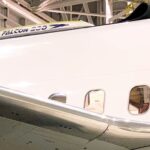
Saudia to Start Flying with Falcon 300 Terminal on Inmarsat’s GX Aviation Service Next Year
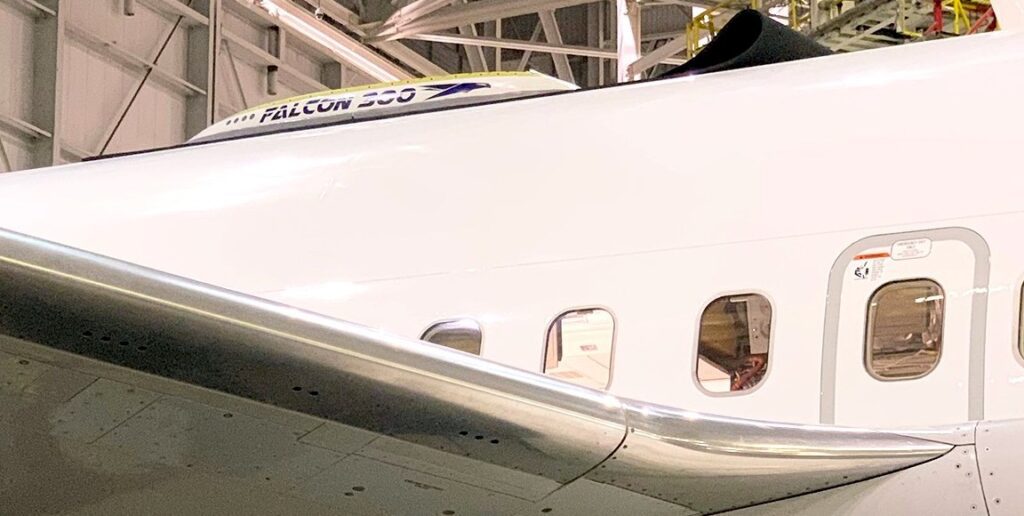
Saudia is on track to start flying Airbus A321 aircraft upgraded with Falcon 300 terminals to enable Inmarsat’s GX Aviation in-flight connectivity (IFC) service early next year. The Saudi Arabian national carrier is ready to start installing and activating the GX connectivity on a fleet of 35 Airbus A321neo and A321XLR aircraft after the completion of a flight trial campaign where Inmarsat tested the performance of the service across “more than 320 simultaneous online user sessions and sustained throughput of over 200Mbps.”
The Falcon 300 terminal has received full type approval for the Airbus A321, according to Inmarsat. Developed in partnership with Inmarsat, Stellar Blu’s Falcon 300 terminal includes a Ka-band mechanical phased array antenna, dual modem MODMAN, and several cabin wireless access points.
Stellar Blu served as the lead on obtaining certification and scheduling installations of the Falcon 300 on Saudia’s Airbus A321s, according to the connectivity terminal provider’s CEO Tracy Trent. In May, during the Future Aviation Forum held in Riyadh, Stellar Blu signed a collaboration agreement with Saudia Aerospace Engineering Industries (SAEI) to include the company’s in-flight connectivity installations as one of the modification services offered at a new one million square meter, custom-designed MRO Village to be located at the King Abdul-Aziz International Airport, Jeddah.
“The fact we have reached this stage in such a short timeframe is testament to the talented engineering teams on both sides, who mainly worked remotely over the last two years and rarely met in person. We look forward to seeing the Falcon 300 onboard SAUDIA’s Airbus A321neo and Airbus A321XLR aircraft, followed by many more airline fleets in the years to come,” Trent said in a statement.
Saudia first made the selection of the Falcon 300 for its Airbus A321 fleet in November 2021 to become the first airline customer for Inmarsat’s OneFi portal. Inmarsat launched the OneFi customer experience platform (CXP) last year as a new digital in-flight passenger experience tool to drive more ancillary revenue from passengers last year.
“The results of our flight trials have demonstrated the terminal’s ability to consistently deliver the highest levels of connectivity, even over the world’s busiest airspaces,” William Huot-Marchand, Inmarsat Aviation’s Senior Vice President of In-flight Connectivity, said in a statement. “And with final type approval now in place, we are fast approaching commercial service at the beginning of next year.”


